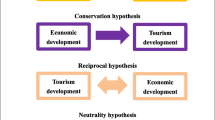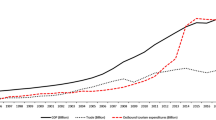Abstract
This study attempts to investigate the relationship between international tourism, trade, and economic growth in India over the period from April 1991 to July 2012. To account for potential asymmetries in the relationship, we make use of new asymmetric Granger-causality tests and frequency analysis. We show that there is bidirectional Granger-causality between trade and tourism in positive components, whereas unidirectional Granger-causality runs from tourism to trade for negative components. Moreover, we find evidence of bidirectional Granger-causality between economic growth and tourism in positive components, but unidirectional Granger-causality running from economic growth to tourism for negative components. On the other hand, the results from frequency analysis provide evidence of Granger-causality between trade and tourism, and also between economic growth and tourism, at different frequency bands.


Similar content being viewed by others
Notes
This section is heavily based on Grinsted et al. (2004). We are grateful to them for making codes available, which was utilized in the present study.
References
Aguiar-Conraria L, Soares MJ (2011) Oil and the macroeconomy: using wavelets to analyze old issues. Empir Econ 40(3):645–655
Aguiar-Conraria L, Azevedo N, Soares MJ (2008) Using wavelets to decompose the time-frequency effects of monetary policy. Phys A: Stat Mech Appl 387(12):2863–2878
Campbell JY, Hentschel L (1992) No news is good news: an asymmetric model of changing volatility in stock returns. J Financ Econ 31(3):281–318
Easton ST (1998) Is tourism just another commodity? Links between commodity trade and tourism. J Econ Integr 13(3):522–543. doi:10.11130/jei.1998.13.3.522
Engle RF, Granger CWJ (1987) Co-Integration and error correction: representation, estimation, and testing. Econometrica 55(2):251. doi:10.2307/1913236
Engle RF, Ng VK (1993) Measuring and testing the impact of news on volatility. J Financ 48:78–1749
Fry D, Saayman A, Saayman M (2010) The relationship between tourism and trade in South Africa. S Afr J Econ 78(3):287–306. doi:10.1111/j.1813-6982.2010.01245.x
Geweke J (1982) Measurement of linear dependence and feedback between multiple time series. J Am Stat Assoc 77(378):304. doi:10.2307/2287238
Gokovali U (2010) Contribution of tourism to economic growth in Turkey. Anatol Int J Tour Hosp Res 21(1):139–153. doi:10.1080/13032917.2010.9687095
Granger CWJ (1969) Investigating causal relations by econometric models and cross-spectral methods. Econometrica 37(3):424. doi:10.2307/1912791
Grinsted A, Moore JC, Jevrejeva S (2004) Application of the cross wavelet transform and wavelet coherence to geophysical time series. Nonlinear Process Geophys 11(5/6):561–566
Gronwald M (2009) Reconsidering the macroeconomics of the oil price in Germany: testing for causality in the frequency domain. Empir Econ 36(2):441–453. doi:10.1007/s00181-008-0204-3
Gunduz L, Hatemi-J A (2005) Is the tourism-led growth hypothesis valid for Turkey? Appl Econ Lett 12(8):499–504. doi:10.1080/13504850500109865
Hatemi-J A (2003) A new method to choose optimal lag order in stable and unstable VAR models. Appl Econ Lett 10(3):135–137
Hatemi-J A (2012) Asymmetric causality tests with an application. Empir Econ 43(1):447–456. doi:10.1007/s00181-011-0484-x
Hosoya Y (1991) The decomposition and measurement of the interdependency between second-order stationary processes. Probab Theory Relat Fields 88(4):429–444. doi:10.1007/bf01192551
Jammazi R (2012) Cross dynamics of oil-stock interactions: a redundant wavelet analysis. Energy 44(1):750–777. doi:10.1016/j.energy.2012.05.017
Kadir N, Jusoff K (2010) The cointegration and causality tests for tourism and trade in Malaysia. Int J Econ Financ 2(1):138
Katircioglu S (2009) Tourism, trade and growth: the case of Cyprus. Appl Econ 41(21):2741–2750. doi:10.1080/00036840701335512
Kulendran N, Wilson K (2000) Is there a relationship between international trade and international travel? Appl Econ 32:1001–1009
Kweka J, Morrissey O, Blake A (2003) The economic potential of tourism in Tanzania. J Int Dev 15:335–351
Lean HH, Tang CF (2010) Is the tourism-led growth hypothesis stable for Malaysia? A note. Int J Tour Res 12:375–378
Lemmens A, Croux C, Dekimpe MG (2008) Measuring and testing granger causality over the spectrum: an application to European production expectation surveys. Int J Forecast 24:414–431
Narayan PK (2004) Economic impact of tourism on Fiji’s economy: empirical evidence from the computable general equilibrium model. Tour Econ 10:419–433
Shan J, Ken Wilson (2001) Causality between trade and tourism: empirical evidence from China. Appl Econ Lett 8(4):279–283
Sims C (1980) Macroeconomics and reality. Econometrica 48:1–48
Suresh KG, Gautam V, Kumar M (2011) Analysing the relationships among tourism, trade, and economic growth in Indian perspective. J Int Bus Econ 12(1):1–11
Toda HY, Yamamoto T (1995) Statistical inference in vector autoregressions with possibly integrated processes. J Econ 66(1):50–225
Torrence C, Compo GP (1998) A practical guide to wavelet analysis. Bull Am Meteorol soc 79(1):61–78
Torrence C, Webster PJ (1999) Interdecadal changes in the ENSO–monsoon system. J Clim 12(8):2679–2690
UNWTO (2013) Tourism highlights 2013 edition
Vacha L, Barunik J (2012) Co-movement of energy commodities revisited: evidence from wavelet coherence analysis. Energy Econ 34(1):241–247
Veronesi P (1999) Stock market overreactions to bad news in good times: a rational expectations equilibrium model. Rev Financ Stud 12(5):975–1007
WTTC (2013) The economic impact of travel & tourism 2013, India, http://www.wttc.org/site_media/uploads/downloads/india2013_1.pdf
Author information
Authors and Affiliations
Corresponding author
Rights and permissions
About this article
Cite this article
Suresh, K.G., Tiwari, A.K. Does international tourism affect international trade and economic growth? The Indian experience. Empir Econ 54, 945–957 (2018). https://doi.org/10.1007/s00181-017-1241-6
Received:
Accepted:
Published:
Issue Date:
DOI: https://doi.org/10.1007/s00181-017-1241-6




